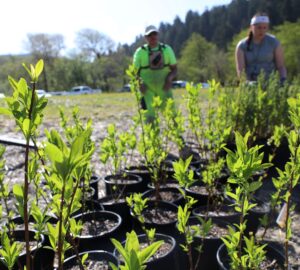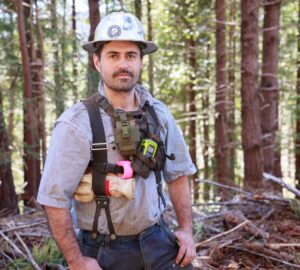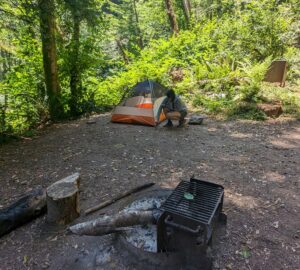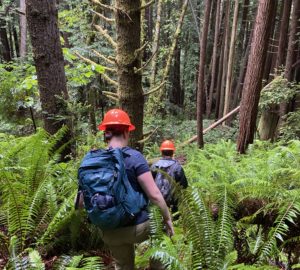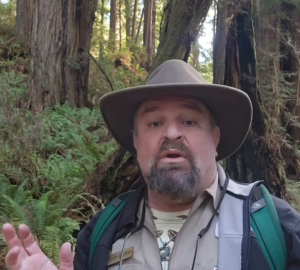Apprentice program opens doors to careers in natural resources
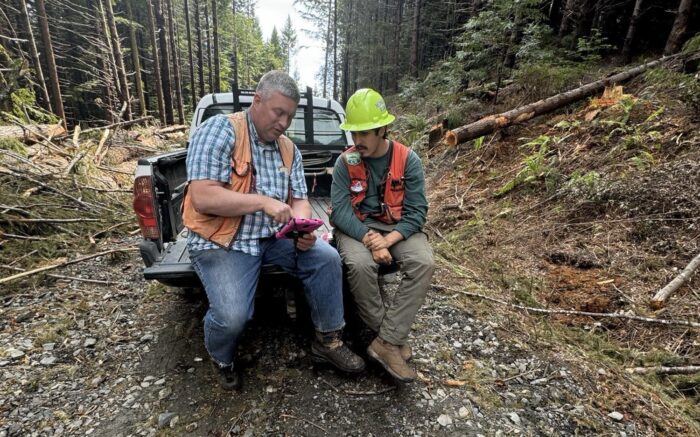
When Francisco Saavedra was in his early twenties, he was sleeping on his uncle’s couch in Crescent City, unsure what to do with his life. Then he heard how tribes on the North Coast were working to undam the Klamath and Eel rivers.
“It occurred to me that if I wanted to live in this area long-term and provide for myself—and hopefully a family—my best shot would be through tribal or environmental work,” says Saavedra. “Otherwise, my options were limited. I’d have to work at the prison or leave the area, because there weren’t jobs in Crescent City or Klamath for someone like me: unskilled, with only a high school diploma.”
Inspired, Saavedra soon enrolled at the College of the Redwoods, where his professor Valerie Elder encouraged him to attend a Society of American Foresters conference. There he saw a presentation on Redwoods Rising. And that’s when everything clicked.
“As a Native American, I’ve always felt I had a spiritual obligation to my landscape,” says Saavedra. “When I heard about Redwoods Rising, I said, ‘Yes, yes, this hits every single ecological niche and restoration goal that I want to be a part of in my lifetime.’ ”
In 2023, he started a Redwoods Rising apprenticeship, learning how to survey the forest and determine which trees needed to be selectively thinned. The next year he returned as a crew leader, conducting assessments of forest health. He even snorkeled in streams to count coho salmon. The experience opened doors for Saavedra, allowing him to get other apprenticeships and jobs.
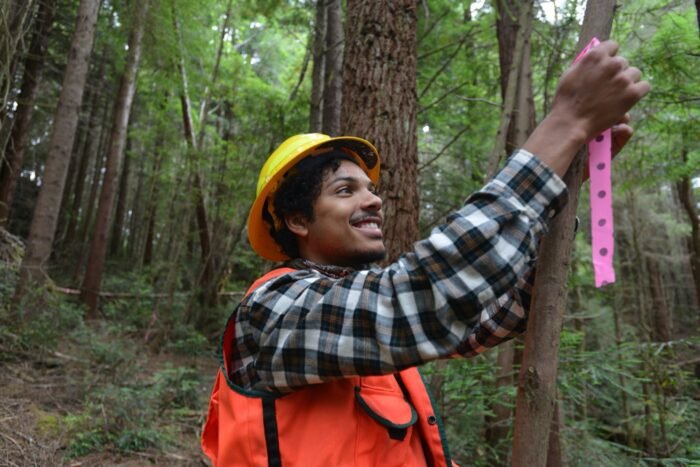
Thus far, Redwoods Rising’s apprenticeship program has trained 93 college students, helping to build the restoration workforce needed on the North Coast and beyond. (A parallel program in the giant sequoias launched in 2024.) Apprentices are not only paid; they also gain valuable skills and expertise they can leverage in their careers. A recent survey of former apprentices found that 72 percent of respondents had continued in the natural resource management field.
“We are creating opportunities for all, with past students going on to work at organizations like California State Parks, the National Parks Service, tribal governments, and forestry companies,” says Erin Kelly, department chair of forestry, fire, and rangeland management at Cal Poly Humboldt, which participates in the apprenticeship program.
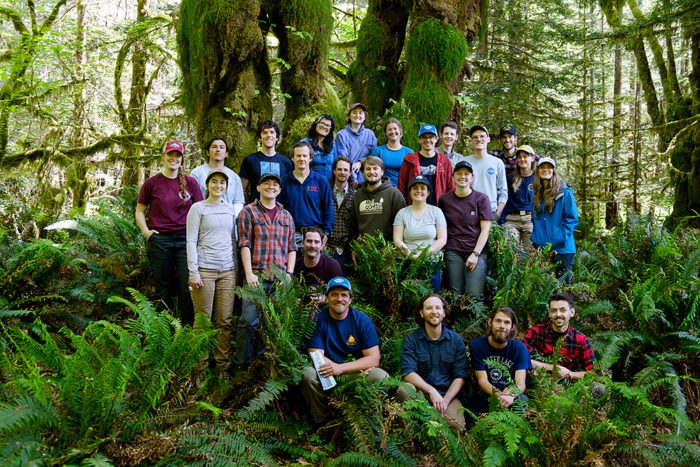
Rhiannon Lopez was a student at Cal Poly Humboldt when she was selected to be the interpretation apprentice for Redwoods Rising. For the next six months, she traveled up and down the North Coast, learning about restoration projects and communicating their importance to the public.
The apprenticeship created opportunities for Lopez, who grew up in Southern California and was the first in her family to graduate from a four-year college. “It was an introductory job into my chosen career path, which was super fundamental, not just economically but also sociologically—seeing these different groups come together and utilize their respective resources.”
Since graduating with a degree in environmental science and management, Lopez has been hired for a two-year fellowship with Save the Redwoods League. Her apprenticeship was key to making that happen. “In this field, getting your first season of work is one of the most important things you can do,” she says.
As for Saavedra, he now serves as a forestry resilience ambassador for the Foundation for California Community Colleges, speaking to students at high schools and community colleges about opportunities within forestry. His journey toward a restoration career continues, aided by the skills and connections he gained as a Redwoods Rising apprentice.
“I’m thankful every day that I was selected, and that I got to be a part of such a great project,” he says. “I really hope that after I get my degree and work hard, that I can continue to be a part of these restoration projects. … I don’t want to do anything else.”
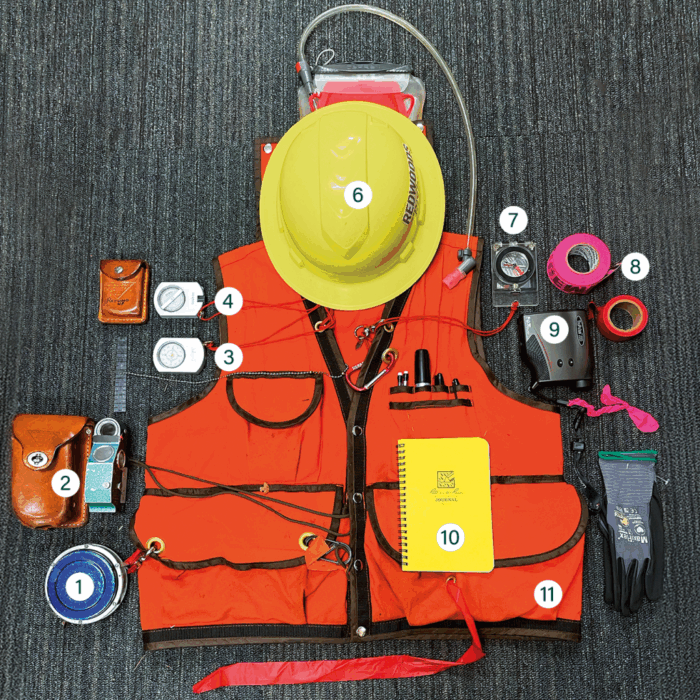
Tools of the Trade
1) Combo diameter tape
A retractable tape measure used to measure tree diameters and distances between plots.
2) Relascope
A specialized instrument used to measure tree height, diameter at different points, and basal area.
3) Bearing compass
Magnetic compass used to determine and plot bearings based on the four cardinal direction quadrants (NSEW).
4) Clinometer
Device with both percent and topo scales, used to measure tree height and determine ground slope.
5) 3-liter CamelBak
A hydration system worn as a backpack. Staying hydrated during long hikes through rugged terrain is crucial for endurance and safety.
6) Hard hat
Essential personal protective equipment (PPE) for field safety—protects against falling debris, low branches, and accidental impacts in dense forest environments.
7) Azimuth compass
Similar to a bearing compass but uses degrees (0–360°) instead of quadrants. Essential for navigating through the woods and laying out accurate plot lines.
8) Flagging tape
Used to mark trees, transect lines, plot boundaries, and notable features. Tape comes in various colors for different purposes.
9) Laser hypsometer and rangefinder
These devices use laser technology to measure tree height and distance—more efficient and precise than manual methods in dense or uneven terrain.
10) Rite in the Rain notebook
Weatherproof notebook for logging data or taking field notes in all conditions—rain, snow, or mist—without losing information.
11) Vest with custom grommets
A durable vest with reinforced grommets or attachment points, allowing gear like tapes and compasses to be clipped on for quick access and hands-free carrying.
This feature appears in the beautiful printed edition of Redwoods magazine, a showcase of redwoods conservation stories, breathtaking photos, and ways you can help the forest. Only a selection of these stories are available online.
Join our thousands of members today for only $25, and you’ll get future editions of Redwoods magazine.

